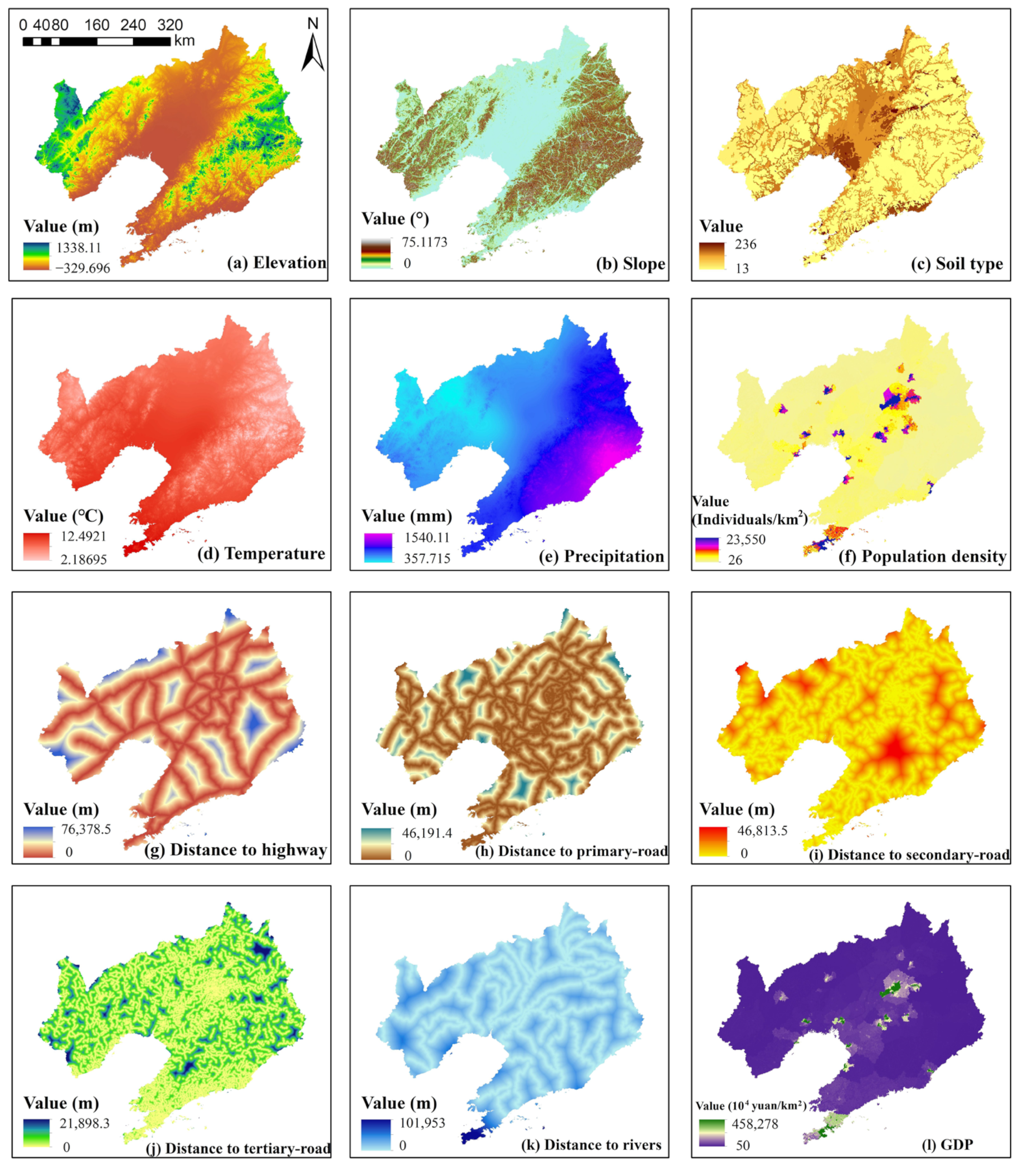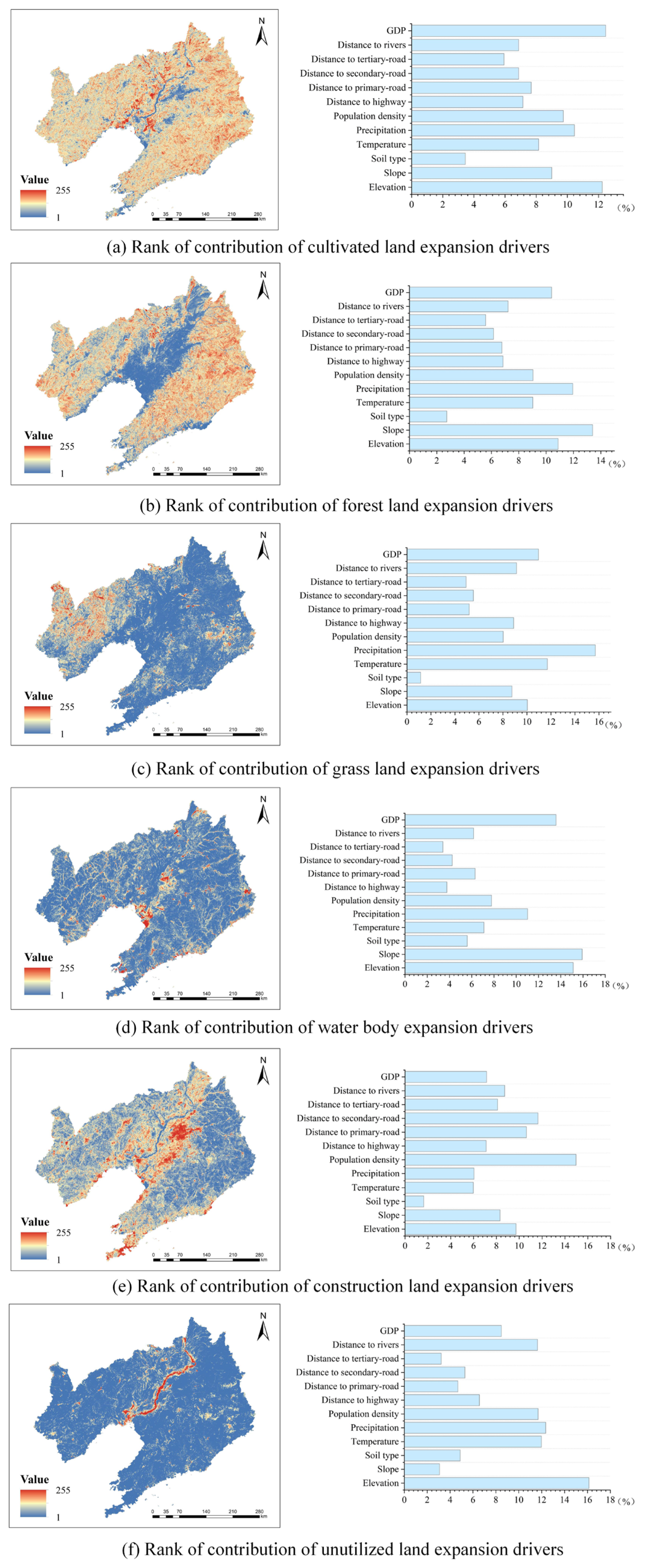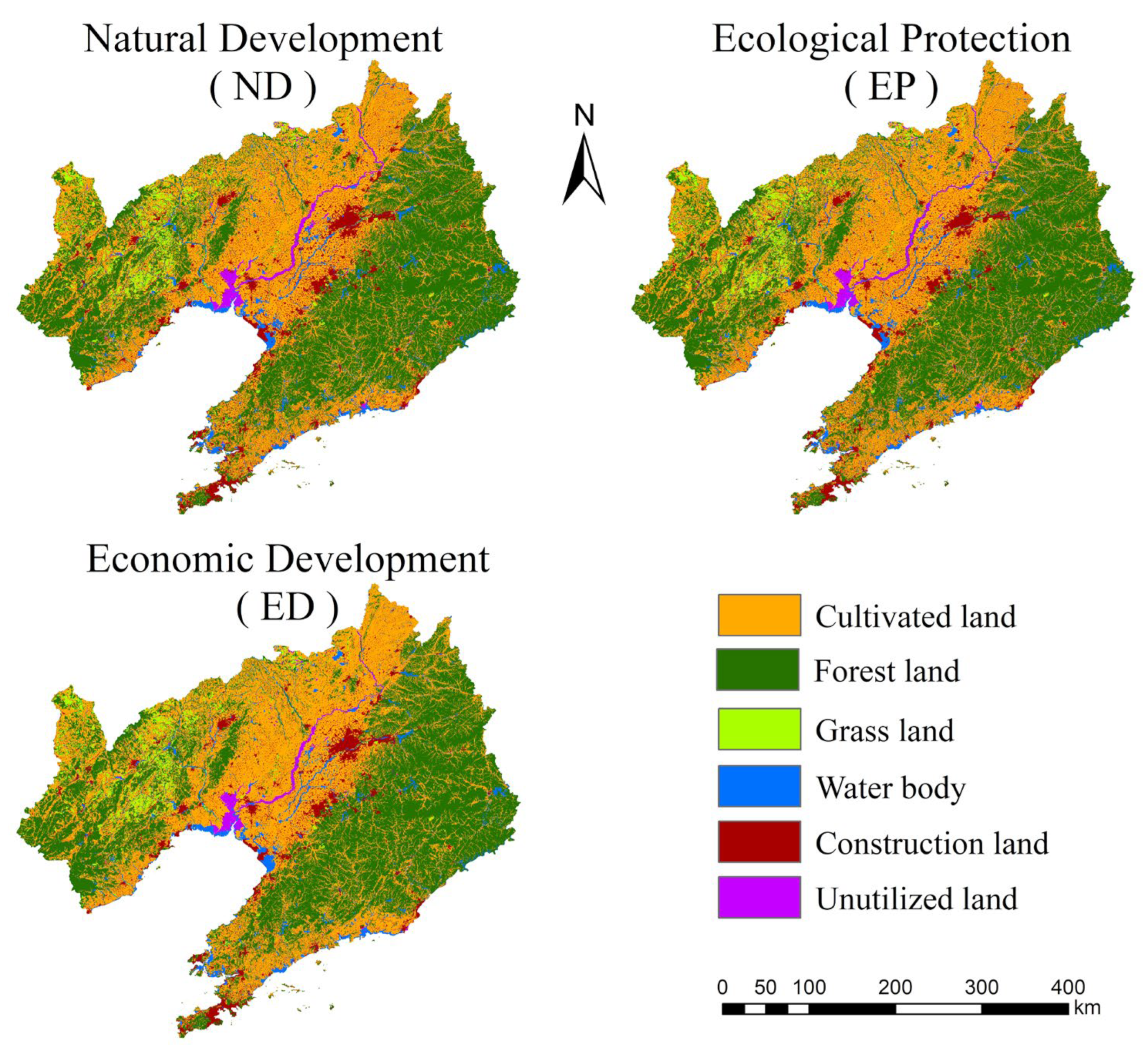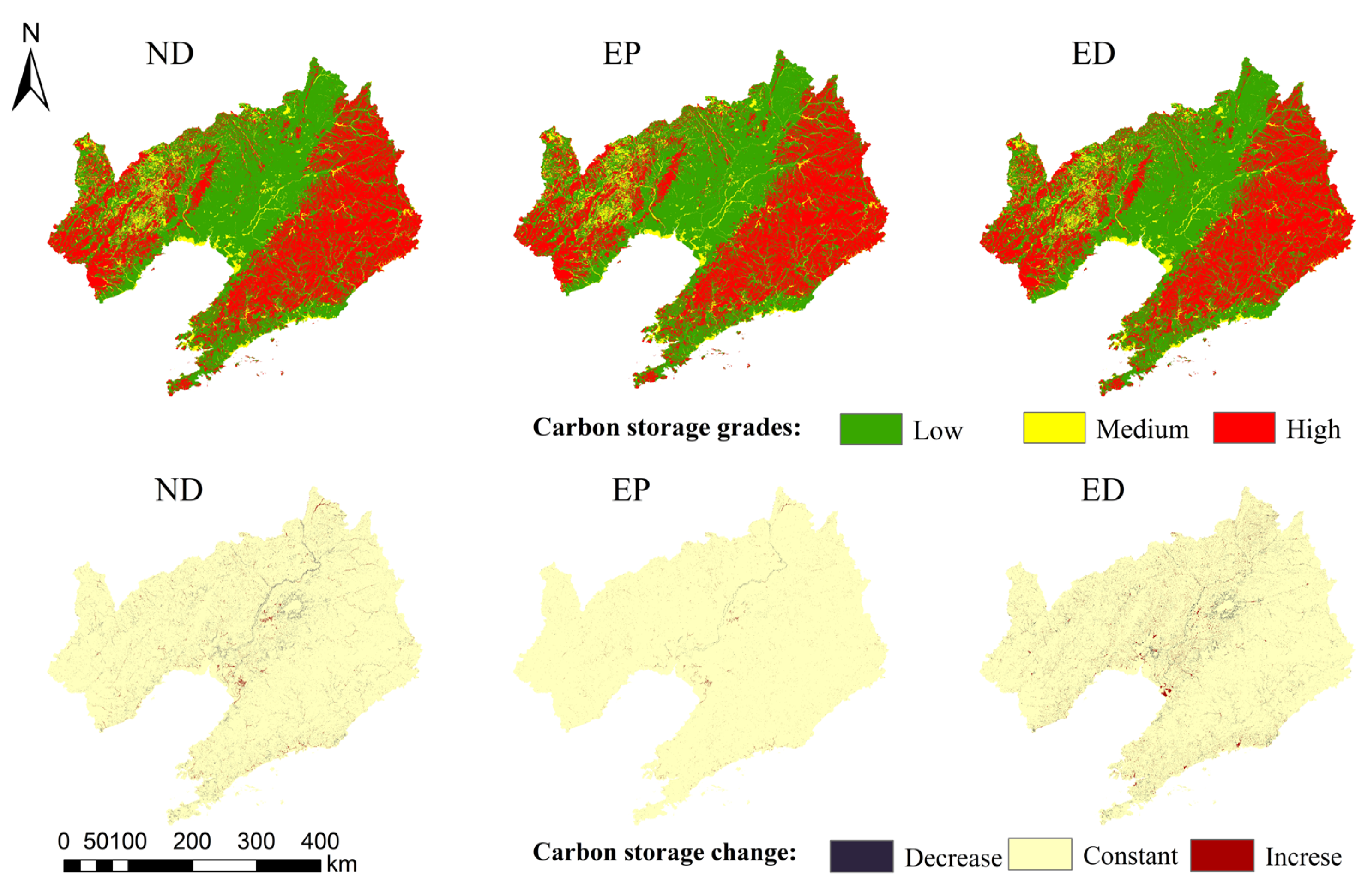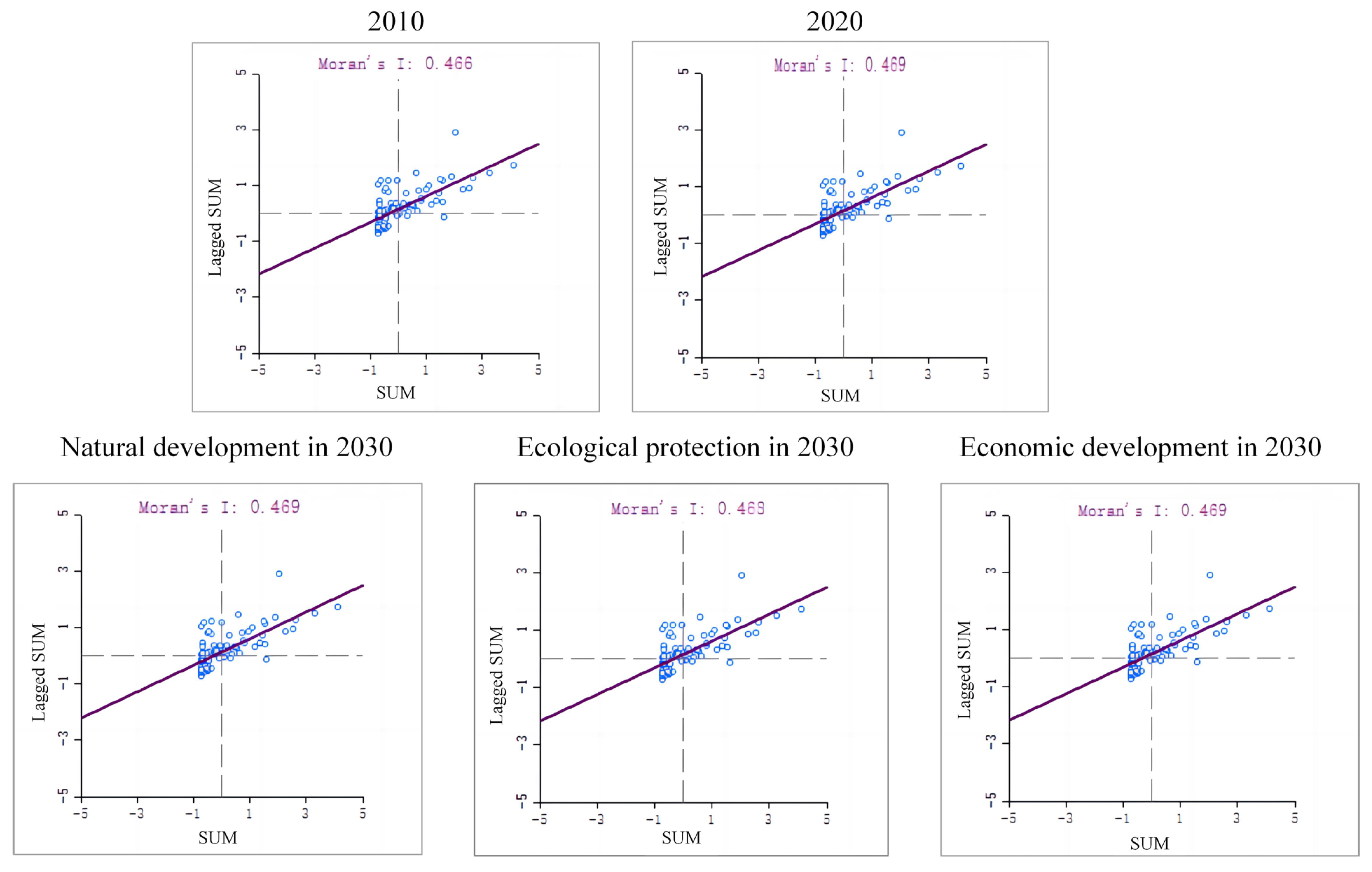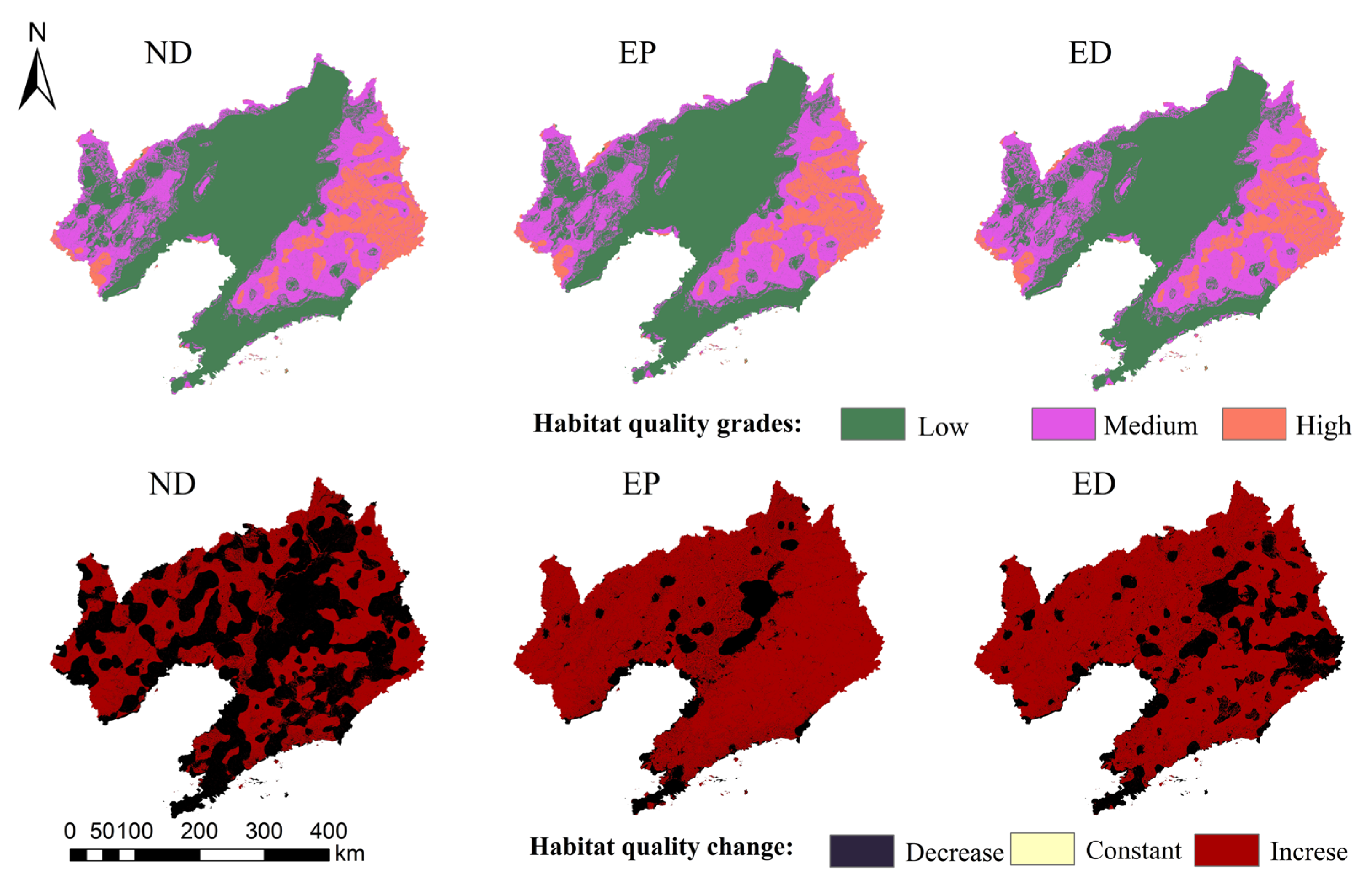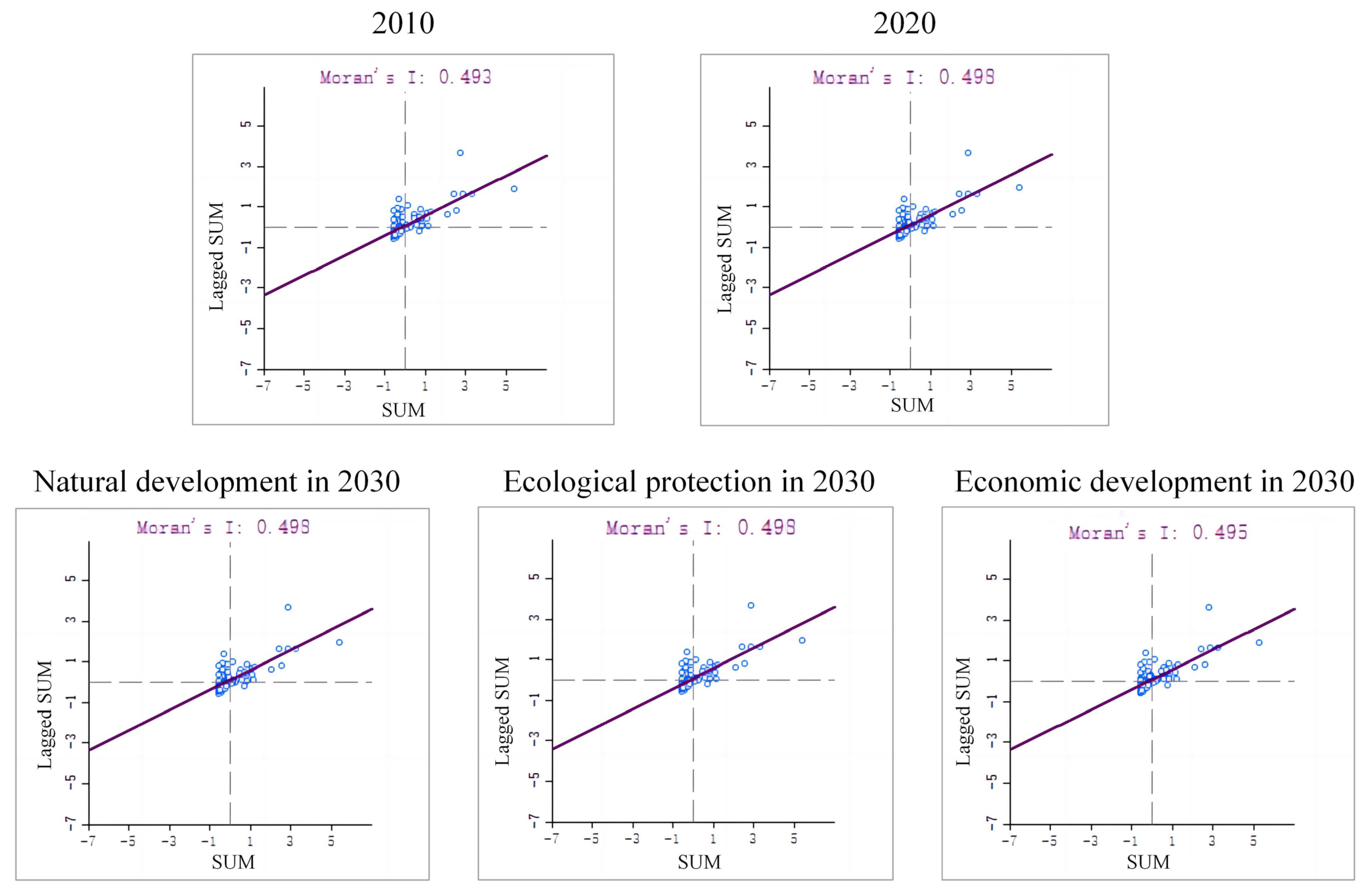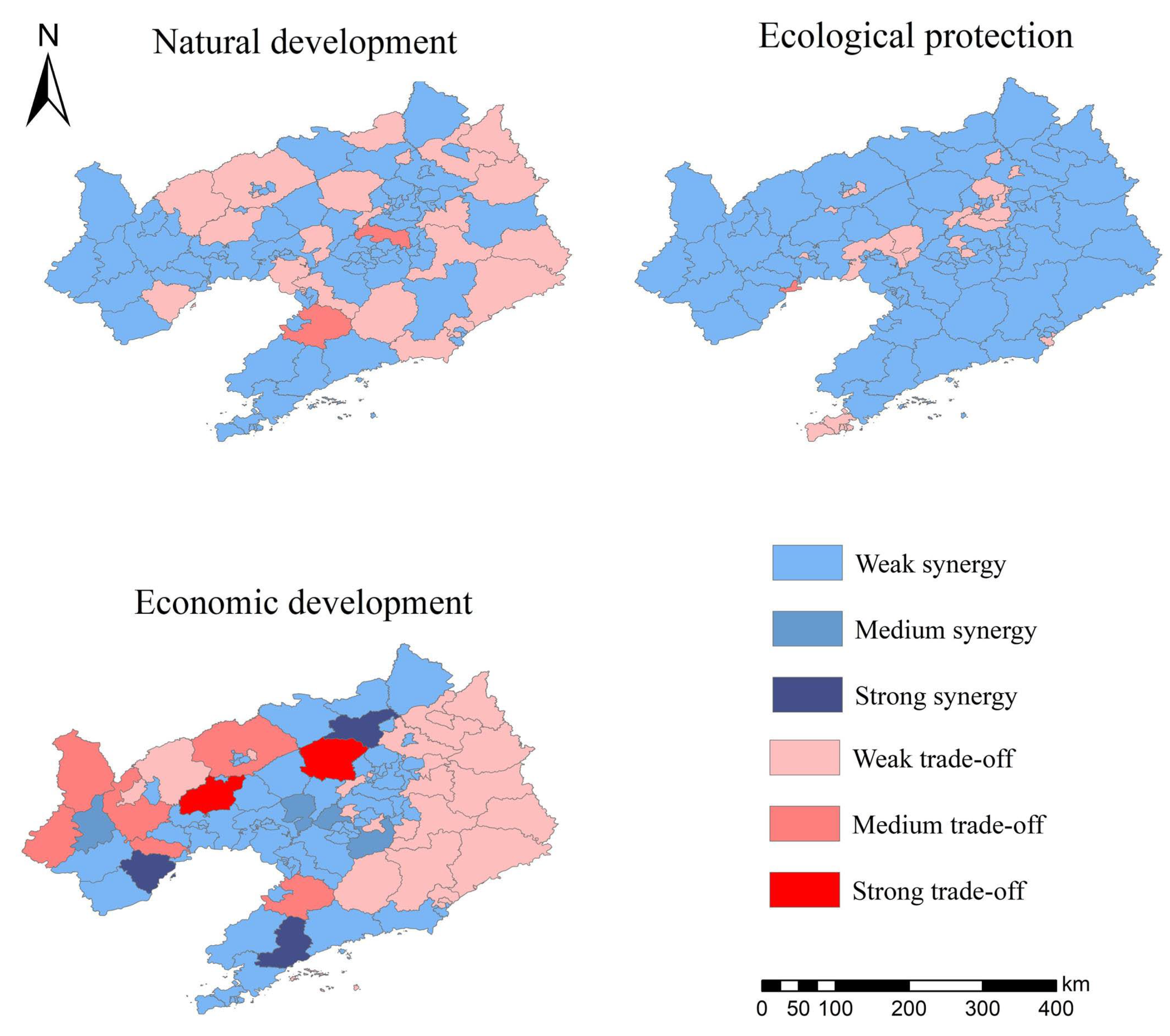1. Introduction
Carbon storage and habitat quality are significant components of ecosystem services [
1,
2] and are crucial for fostering human well-being [
3]. By altering ecosystem structure and function, land use/cover change (LUCC) has an impact on regional carbon storage [
4], is a significant contributor to the shift in carbon storage in entire ecosystems [
5], and influences the regional and even universal carbon balance [
6,
7]. Carbon emissions caused by LUCC are second only to fossil fuel combustion as a source of emissions [
8]. Scientifically sound land use and management practices can re-fix approximately 60–70% of depleted carbon [
9]. The term “habitat quality” refers to an ecosystem’s capacity to offer favorable circumstances for long-lasting growth, and, to a certain extent, represents the region’s biodiversity [
10] and has become a key factor to measure the ecological health and sustainability of a region. Urbanization research and practice show that urbanization and industrial restructuring based on changes in land use patterns and intensities have greatly changed the integrity, structure, and functionality of the original habitat and produce serious stress effects on the ecological environment, even bringing a range of problems, including ecosystem degradation and excessive consumption of water and soil resources [
11]. Multi-scenario simulations can effectively highlight the underlying issues and conflicts in urban ecology under future land change scenarios [
12]. Predicting the future trend of carbon storage and habitat quality changes and revealing the correlation between them are urgently needed to be the basis of ecological civilization construction and to offer a scientific foundation for enhancing ecological services by humans.
There are many studies on carbon storage and habitat quality, and one of the more classic assessment methods is to correct the equivalence factor with the actual situation in the study area and to obtain the value of ecosystem services from a monetary perspective based on land use data [
13]. However, this method is too dependent on land use classification, and it is difficult to obtain data for small- and medium-scale study areas, so the scope of application is limited [
14]. At present, scholars have generally studied the scale effects, spatial patterns, and driving mechanisms of ecosystem service trade-offs and synergistic relationships, mainly at large scales, such as urban agglomerations [
15], forests [
16], and municipalities [
17], and at small scales, such as counties [
18], coastal zones [
19], watersheds [
20], and mountain regions [
21], with the help of models such as the integrated valuation of ecosystem services and trade-offs (InVEST [
22]), artificial intelligence for eco-system services (ARIES [
23]), and social values for ecosystem services (SolVES [
24]) models. Among them, the InVEST model is widely used because of its simple input parameters, high applicability, and accuracy [
25]. The model has been used by scholars in many countries and regions to explore the response mechanisms of land use change and socio-economic and population development levels to terrestrial ecosystem services, and has been applied in spatial planning, ecological compensation, risk management, climate change adaptation, and other environmental management [
26]. However, most studies have only analyzed the spatial distribution of carbon storage and habitat quality and have not yet considered their spatially correlated characteristics. In this study, counties were selected as the study scale, and spatial autocorrelation analysis of regional carbon storage and habitat quality was conducted using GeoDa software.
The simulation predictions of land use mainly include quantitative prediction, spatial simulation, and coupled models [
27,
28]. Among these, LUCC quantity prediction models mainly include logistic regression models based on fixed mathematical formulas [
29], gray prediction models [
30], and Markov models [
31]. There are also widely used system dynamics [
12] and neural network models [
32], while spatial simulation and coupled models are mainly based on cellular automation (CA) models. CA models can be divided into two categories according to the transformation rule mining strategy: the first is the transformation analysis strategy (TAS), mainly including logistic-CA [
33] and artificial neural network-cellular automata (ANN-CA) [
34]; the second is pattern analysis strategy (PAS), mainly including CA-Markov [
35], future land use simulation (FLUS) [
36], and the conversion of land use and its effect at a small regional extent (CLUE-S) model [
37]. Because of the limitations of existing CA models in terms of transformation rule mining strategies and landscape dynamic change simulation strategies [
38] and the difficulties in simulating the patch increase in various land types at fine scales [
39,
40], this has also led to a greater limitation of CA models in practical planning and policy formulation. Liang et al. [
41] proposed a raster-based patch-generating land use simulation (PLUS) model that can effectively explore the driving factors of land expansion and simulate the evolution of patches with multiple land types. This study predicts the demand for each land type in 2030 through the Markov chain method provided by the PLUS model, while related studies have shown that the PLUS model can accurately simulate the nonlinear relationship during the change in various land use type patches with high simulation accuracy [
42]. Therefore, coupling the PLUS and InVEST models can achieve dual optimization of the structure and organization of regional land and maximize the future carbon storage of terrestrial ecosystems.
Liaoning Province, as an old industrial urban agglomeration since the founding of China, is an important link between the Bohai Economic Zone and the Northeast Economic Zone, and it has made great contributions to the economic development of China. However, due to the transformation of China’s economy, land use changes and heavy industrial development have posed great challenges to the sustainable development of Liaoning Province. We aimed to (1) obtain the simulated land distribution map for 2020 by applying the PLUS model and verifying its accuracy, (2) anticipate the land pattern under three scenarios of natural development (ND), ecological protection (EP), and economic development (ED) in 2030, (3) predict the characteristics of carbon storage and habitat quality in 2030 by using the InVEST model and perform a univariate spatial autocorrelation analysis, and (4) to analyze the bivariate spatial autocorrelation between carbon storage and habitat quality by applying the GeoDa platform [
43,
44] and the trade-offs and synergistic relationships between the two. The findings of this study are intended to seek the optimal solution for urban planning under “carbon peaking and carbon neutrality” goals, as well as to be a guide for other Chinese cities [
45,
46]. The specific flowchart is shown in
Figure 1.
4. Discussion
During 2010–2020, nearly 70% of the area transferred to construction land came from arable land, which may be related to the accelerated urbanization process and the massive encroachment of construction land into non-construction land around the city to meet the needs of urban development. By 2020, 37.42% of the lost arable land was converted into forest and grassland, closely related to the implementation of the local policy of returning farmland to forest. The northwestern and southeastern parts of the study area were clustered with forest and grassland, while the central part was dominated by arable land, along with a high concentration of construction land. The reason for this is that the northwestern and southeastern parts of the study area have higher topography and lower levels of human activity, while the central part is flat and relatively rich in water resources, making it more livable. In addition, this study used the PLUS model to simulate the land use distribution pattern under multiple scenarios in 2030 and used the random forest algorithm to mine the development probability and driving factors of each land use type. Therefore, the LUCC prediction results in this study were only based on maintaining the state of historical trends and applied to subsequent ecosystem service analysis. The simulation accuracy can be further improved if the natural and social drivers are expanded. Although different development scenarios, ND, EP, and ED, were set in this study, there was still a gap between the three types of development pattern sets and the real development scenarios, which cannot cover all future development patterns. Therefore, setting a more realistic amount of future land use demand in conjunction with local policies and narrowing the gap between development scenarios and real development scenarios will become a priority for future land forecast studies.
The northwestern and southeastern regions of Liaoning Province with a higher altitude and high forest density had stronger ecosystem service capacity and gathered areas with high values of carbon storage and habitat quality, and all of them exhibited spatial aggregation between similar values. There were few previous studies on ecosystem services in Liaoning Province, so the results of relevant studies in nearby regions were selected for comparative analysis. Xiang et al. [
68] showed the spatial similarity of ecosystem service functions in Northeast China. Mao et al. [
69] showed that significant changes in arable and construction land in Northeast China tend to exacerbate landscape fragmentation, which in turn causes a decline in carbon storage and habitat quality. In addition, Wang et al. [
70] found that the high-value areas of ecosystem services in Northeast China were mainly distributed in the northwest and southeast from the perspective of ecosystem service valuation, which is consistent with the distribution characteristics of carbon storage and habitat quality in this study. However, the strict implementation of ecological protection will inevitably contradict the need for rapid economic development, and land use optimization is an essential tool for balancing this paradox. Zoning evaluation of the study area in combination with sensitivity can be considered in the future.
This study concluded that the reduction in habitat quality was particularly pronounced around cities and watersheds, that future urban expansion should be reasonably planned and controlled, and that watersheds should be protected to obtain greater ecological benefits. However, there is a lack of scientifically accurate and uniform parameter setting systems when measuring habitat quality; thus, future studies should focus on exploring effective ways to optimize parameter settings. In addition, we identified trade-off and synergy connections between carbon storage and habitat quality in various development scenarios in 2030, which may provide informative implications for decision-making to improve regional sustainability. In recent decades, ecological construction in the Tohoku region has been influenced by numerous national socioeconomic developments and ecological conservation policies, with a national food security program aimed at increasing food production [
69] and several ecological conservation projects promoting carbon sequestration and soil conservation [
71]. Therefore, future research on multiple ecosystem service functions should consider increasing important service categories, such as water yield, soil conservation, and crop production. Additionally, it is necessary to further explore the reasons for the shift in the synergistic relationship of ecosystem trade-offs, strengthen research on the underlying mechanisms and driving mechanisms, and propose more flexible land management strategies and ecological restoration measures to promote multiple wins among resources, population, economy, and ecology, optimizing ecosystem services, and coordinated regional development.
5. Conclusions
In Liaoning Province, both the pattern of carbon storage and habitat quality revealed a declining trend from the northwest and southeast to the center, and both showed positive spatial correlation. The total carbon storage in 2010, 2020, and the natural development (ND), ecological protection (EP), and economic development (ED) scenarios in 2030 were 16.0640 108, 15.9964 108, 15.9558 108, 16.0747 108, and 15.9920 108 Mg/C, respectively, and were dominated by low- and high-value carbon storage, which encompassed more than 50% and 41% of the total area of the research region, respectively. In addition, habitat quality changed in most areas of Liaoning Province from 2010 to 2030 and was dominated by low-value habitat quality areas, which accounted for 54% of the total research area.
The area of reduced habitat quality area increased dramatically in the ND scenario. Compared to that of the ND scenario, habitat quality in the EP and ED scenarios was generally increasing, and habitat quality improved significantly. In summary, the EP scenario was the only development prospect with increasing total carbon storage, which could increase carbon sequestration by approximately 7.83 106 Mg/C and was also a development prospect with optimal habitat quality. Therefore, the construction of ecological projects to expand the area of high carbon storage value and enhance the regional carbon sequestration capacity can effectively enable Liaoning Province to achieve the goal of “carbon neutrality and carbon peaking”.
Finally, it was found that habitat quality in Liaoning Province influenced carbon storage to some extent, with Moran’s I values of 0.462, 0.461, and 0.463. Weak trade-off and synergy dominated in the ND scenario; most regions showed weak synergy in the EP scenario; spatial heterogeneity became more pronounced in the ED scenario, with strong trade-off and synergy emerging in individual regions. The synergistic area-wide ecosystem services and urban public services have reached a high level and achieved a coordinated development, which is the ultimate goal of sustainable urban development. For trade-off areas, a strict ecological protection system should be implemented in the early stage of urban development, and this should be used as the urban center for urbanization.


